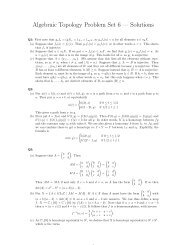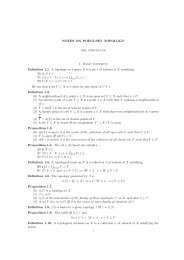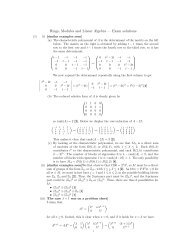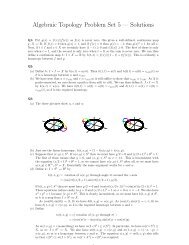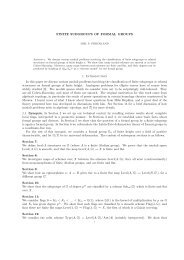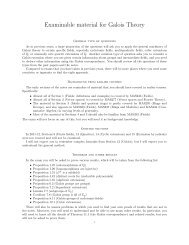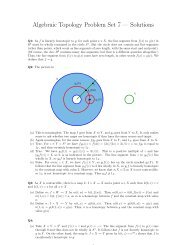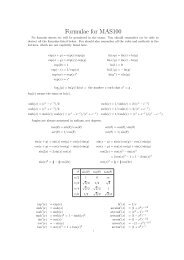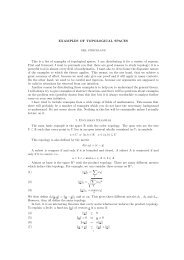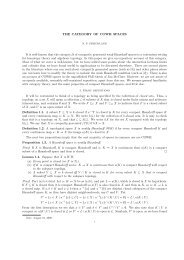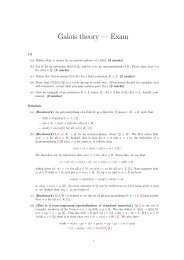TOPOLOGY PROBLEMS (1) State the Arzela-Ascoli ... - Neil Strickland
TOPOLOGY PROBLEMS (1) State the Arzela-Ascoli ... - Neil Strickland
TOPOLOGY PROBLEMS (1) State the Arzela-Ascoli ... - Neil Strickland
You also want an ePaper? Increase the reach of your titles
YUMPU automatically turns print PDFs into web optimized ePapers that Google loves.
<strong>TOPOLOGY</strong> <strong>PROBLEMS</strong> 7<br />
(30) Given a complex number c, define q c (z) = z 2 + c and<br />
f n (c) = q c (q c (q c . . . (0) . . .))<br />
where q c is applied n times. In o<strong>the</strong>r words:<br />
f 0 (c) = 0<br />
f n+1 (c) = q c (f n (c)) = f n (c) 2 + c<br />
(a) Give formulae for f 1 (c), f 2 (c) and f 3 (c).<br />
(b) Prove that f n : C −→ C is continuous. A little care is needed here to avoid talking<br />
nonsense.<br />
(c) The Mandelbrot set M is defined as<br />
M = {c ∈ C | |f n (c)| ≤ 2 for all n}<br />
Prove that M is bounded and closed.<br />
Later on, we shall prove some o<strong>the</strong>r topological properties of M, including <strong>the</strong> fact that<br />
it has no holes. It is also known that M is connected, but this is a deep result, relying<br />
on some substantial work in complex analysis. It is also known that M is <strong>the</strong> closure<br />
of its interior. One of <strong>the</strong> most important questions about M, which I believe is still<br />
unanswered, is whe<strong>the</strong>r it locally connected. It is known that many interesting things<br />
would follow from this.<br />
(31) Let X be a compact Hausdorff space, and C(X) <strong>the</strong> set of continuous functions u: X −→ R.<br />
Define two maps b and t (“bottom” and “top”) from C(X) to R by<br />
b(u) = min{u(x) | x ∈ X}<br />
t(u) = max{u(x) | x ∈ X}<br />
(why are <strong>the</strong>se finite ?). Prove that t and b are continuous.<br />
A measure on X is defined to be a map µ: C(X) −→ R such that<br />
(a) (linearity) µ(au + bv) = aµ(u) + bµ(v) ( where a, b ∈ R and u, v ∈ C(X)).<br />
(b) (positivity) if u ≥ 0 (i.e. u(x) ≥ 0 for all x) <strong>the</strong>n µ(u) ≥ 0.<br />
(c) (normalisation) µ(1) = 1 (where <strong>the</strong> first 1 is <strong>the</strong> constant function).<br />
Here are some examples with X = [0, 1]:<br />
(a) δ(u) = u(0) (<strong>the</strong> Dirac measure).<br />
(b) λ(u) = ∫ 1<br />
u(x)dx (Lebesgue measure).<br />
0<br />
(c) ρ n (u) = 1 ∑ n<br />
n+1 k=0 u(k/n)<br />
We shall consider <strong>the</strong> following infinite product space:<br />
Z =<br />
∏<br />
[b(u), t(u)] ⊂<br />
∏<br />
R<br />
u∈C(X)<br />
u∈C(X)<br />
(a) Describe <strong>the</strong> elements of Z. This is not supposed to be a deep question; just transcribe<br />
<strong>the</strong> general definition of an infinite product and perhaps tidy up <strong>the</strong> result a bit.<br />
(b) Give two examples of elements of Z.<br />
(c) Show that if µ is a measure <strong>the</strong>n b(u) ≤ µ(u) ≤ t(u).<br />
(d) Show that every measure µ is a continuous map C(X) −→ R. (This is not actually<br />
relevant to what follows).<br />
(e) Define an injective function j : M(X) −→ Z (<strong>the</strong>re is only one reasonable one).<br />
(f) Given u, v ∈ C(X) consider <strong>the</strong> set<br />
A u,v = {α ∈ Z | π u (α) + π v (α) = π u+v (α)}<br />
Show that A u,v is closed in Z and contains j(M(X)). By elaborating on this idea,<br />
show that j(M(X)) is closed in Z and thus compact. We identify M(X) with<br />
j(M(X)) and give it <strong>the</strong> subspace topology.<br />
(g) Show that µ n −→ µ in M(X) iff µ n (u) −→ µ(u) for every u ∈ C(X). In particular, you<br />
can show that ρ n −→ λ in M([0, 1]).<br />
(0) Which of <strong>the</strong> following pairs (X, d) is a metric space ?<br />
(a) X = R n , d(x, y) = ∑ n<br />
k=1 k|x k − y k |




